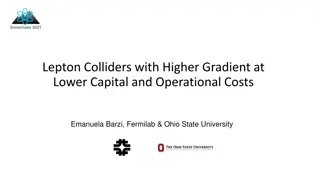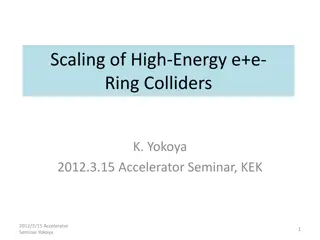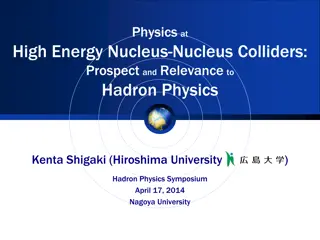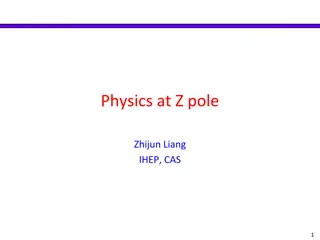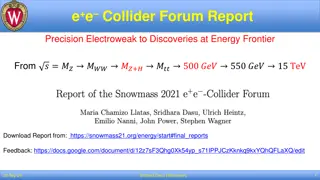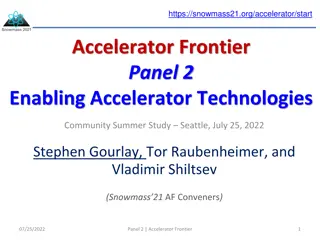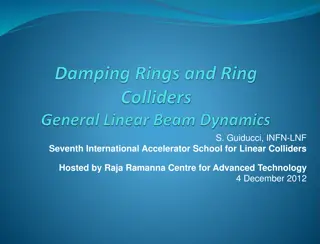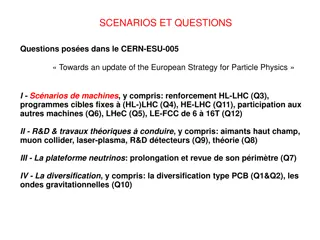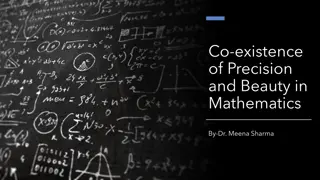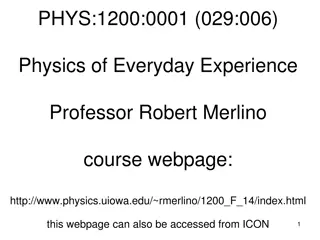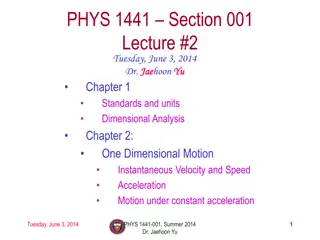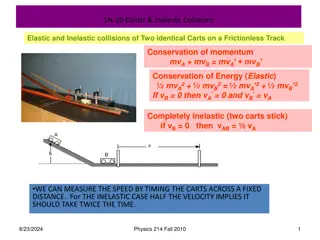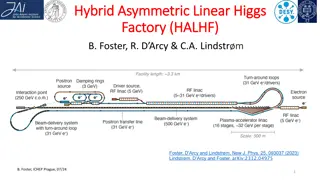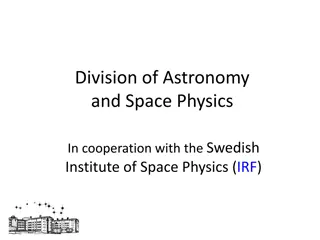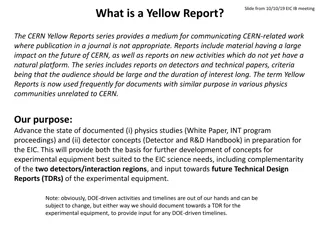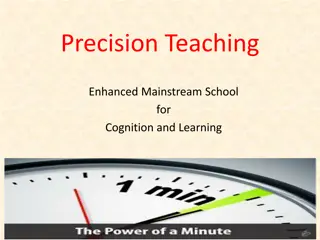Precision Physics at Colliders: Choosing Wisely, Measuring Carefully, and Exploiting Ruthlessly
Precision Physics at Colliders explores the selection, measurement, and utilization of data at colliders, focusing on fundamental symmetries and parameters of the Standard Model. The lectures cover topics such as QCD, top, electroweak, and flavor physics, emphasizing the importance of precision measurements in experimental validations. The sessions delve into various methodologies and challenges in achieving accurate collider measurements. Specific lectures discuss QCD phenomena, jet production, and the strong coupling constant, illustrating the intricate processes involved in extracting precise data from collider experiments.
Download Presentation

Please find below an Image/Link to download the presentation.
The content on the website is provided AS IS for your information and personal use only. It may not be sold, licensed, or shared on other websites without obtaining consent from the author. Download presentation by click this link. If you encounter any issues during the download, it is possible that the publisher has removed the file from their server.
E N D
Presentation Transcript
Precision Physics at Colliders HOW TO CHOOSE WISELY, MEASURE CAREFULLY, AND EXPLOIT RUTHLESSLY
Standard Model Physics and Precision These lectures nominally meant to cover LHC experimental results and methods in QCD/top/electroweak/flavor physics, i.e., the most direct predictions of the Standard Model (excluding our newest member of the family, the Higgs field and its boson). A complete survey of these in three lectures is so broad as to not be meaningful! Precision measurements was alternatively suggested. That doesn t quite narrow it down either. Lots of precise measurements are available with LHC data but not all of them are created equal. 3
Standard Model Physics and Precision I have chosen to focus on precision measurements which bound the fundamental symmetries and parameters of the Standard Model, as well as the experimental validation of phenomenology required to make them. Some common methods and problems arise out these case studies of relevance for precision collider measurements of all types. Precision requires time and understanding. Many of these measurements are based on Run 1 data, with Run 2 versions still in progress. 4
Syllabus: Review of six measurements Lecture 1, Friday Aug. 24 The miracle of QCD: jets, tops, and S Lecture 2, Sunday Aug. 26 The vise of precision electroweak: sin2 W and MW Lecture 3, Monday Aug. 27 The mystery of flavor: Capturing Wilson coefficients and testing lepton universality 5
Precision Physics at Colliders 1: THE MIRACLE OF QCD
QCD, Jet phenomena, and the Strong Coupling QCD is (at LHC scales) perturbatively calculable, asymptotically free, has no broken symmetries, and depends only on quark masses and a single coupling constant to describe a huge range of high energy phenomena Jet production Jet fragmentation Parton distribution function scaling with Q2 Hadronic event shapes and energy flow correlations Deep inelastic scattering Lecture 1 goal: We will address here how quark/gluon production can be measured to maximum precision and used to precisely obtain the strong coupling constant. 7
Jets Qualitatively, jets are a directed flow of particle energy, indicative of the existence of a hard free quark or gluon in the proton scattering, which has subsequently fragmented and hadronized. Several steps to simulating and reconstructing jets: The hard scattering of the quarks/gluons at a high energy scale Q (pQCD Feynman diagrams) Fragmenting of the free parton into multiple softer partons (parton showering via pQCD-inspired methods and approximations) Hadronization of soft partons at a GeV scale into (possibly unstable) hadrons Decay of unstable hadrons into (quasi)-stable particles (K, pi, p, n, leptons) 8
Jets: jet clustering arxiv:0802.1189 Several steps to simulating and reconstructing jets: Stable particles are detected in various ways Charged hadrons (pions, kaons, protons): tracks and hadronic energy clusters Neutral pions: decay to two photons Other neutral hadrons (n, K0): hadronic energy with no track e, mu: tracks with electromagnetic clusters or muon chamber tracks A clustering algorithm determines how detected particles can be aggregated into jets based on their energy and direction Consider all particle pairs, i,j Anti-Kt: p = -1 If dij is the smallest, replace i and j with a combination If diB is the smallest, terminate jet clustering Hard anti-kt jets are circular in y-phi space of radius R (0.5, 0.7, 1.0); softer ones are crescents 9
First Attempt at s: Measure Jets and Their Cross Sections
Jet Cross Sections arxiv:1609.05331 To fully disentangle the effects of PDFs and the strong coupling, the jet production cross section must be sampled as a function of jet PT and jet rapidity over the widest achievable ranges Ingredients: An accurate determination of jet energy and resolution Luminosity measurement Precise pQCD prediction Unfolding Strong coupling constraint 11
Jet Samples and Efficiencies Jets can be captured from the trigger by selecting high energy calorimeter clusters. Below 500 GeV jet PT, prescaled triggers are necessary For lowest PT jets (<100 GeV), special low-pileup runs are necessary Offline selection is ~150% of trigger threshold, to guarantee ~100% trigger efficiency and good sample overlap 12
*c < 1 cm and excluding neutrinos Jets: jet energy corrections arxiv:1607.03663 The ideal detector will measure all particles produced The observable to be recovered and compared with prediction is what the jet clustering algorithm returns for generator level stable* particles You measure what the algorithm returns for detected particles, which may have mismeasured energy, noise, inefficiencies, and pileup Jet energy corrections attempt to convert the measured result into the best estimator of the ideal one. Assume we start with properly calibrated particles/topoclusters which have been clustered In CMS, four classes of corrections applied: Pileup and noise subtraction Detector response vs PT and eta as judged by simulation Residual corrections which account for unmodeled detector effects Flavor-specific corrections which model simulated flavor-specific behavior 13
Jets: pileup corrections BX-id and separation of calorimeter pulse shapes used to remove out-of-time energy Upon identifying the primary vertex, remove charged hadrons/leptons inconsistent with it (CHS, charged-hadron subtraction ) Algorithms to identify energy flow patterns consistent with random clustering of pileup energy ( pileup jet ID ) Estimators of neutral hadron energy from pileup Estimate median energy density and subtract that from the jet area (with PT and eta- dependent corrections) Use energy-flow information to probabilistically infer neutral pileup ( PUPPI !) 14
Jets: pileup corrections BX-id and separation of calorimeter pulse shapes used to remove out-of-time energy Upon identifying the primary vertex, remove charged hadrons/leptons inconsistent with it (CHS, charged-hadron subtraction ) Algorithms to identify energy flow patterns consistent with random clustering of pileup energy ( pileup jet ID ) Estimators of neutral hadron energy from pileup Estimate median energy density and subtract that from the jet area (with PT and eta- dependent corrections) Use energy-flow information to probabilistically infer neutral pileup ( PUPPI !) 15
Jets: response corrections Inside the tracker acceptance (BB, EC1), 90-95% of jet energy can be reliably accounted for in AK5 jets. The more forward calorimetry can only capture 70-80%. After correcting for this effect using simulations, the residual variations with jet pT and rapidity are of order 1% on average. 16
Jets: residual corrections The relative residual jet response versus rapidity is estimated from data by analyzing the PT balance between dijets: This results in corrections of order 1-5% for barrel and endcap and 10-15% for forward jets. Differences in ISR/FSR and a possible logPT dependence is also introduced to this correction. An absolute response correction vs. rapidity and PT is obtained from a global fit to Z+jet, photon+jet, and multijet data, where Z and photon energies serve as an absolute reference. 17
Jets: flavor corrections Corrections up to this point have averaged over hard scattering parton flavor. But response varies by several percent (gluons lowest response, u/d highest). of these effects are uncertain at the 2% level (leading JES uncertainty) Fragmentation/hadronization/UE modelling 18
Jets: energy scale uncertainty and resolution Total uncertainty on JES is up to 2-3% for lowest jet PT, <1% for highest jet PT. Predominant components are flavor corrections and absolute scale from data. Jet energy resolution is typically 15-20% at 30 GeV, 10% at 100 GeV 5% at 1000 GeV Corrections to simulated resolutions derived from dijet balancing, pileup dependence is relevant below jet PT of 100 GeV 2-4% uncertain in the barrel 6% in the endcaps 20% in the forward (large MC variations) 19
Luminosity measurement CMS-PAS-LUM-12-001 Find observables vis which respond linearly to the instantaneous luminosity of each colliding proton bunch pair in a detector. Typically are tracker hits or energy deposits of various kinds resulting from (perhaps multiple) inelastic pp scattering(s), with visible cross section for occurrence vis. Then for NBX bunch pairs, and LHC bunch revolution frequency f, the instantaneous luminosity is time period ( lumi-segments ). Monitor L and time-integrate it across a run to determine integrated luminosity across some basic compute total integrated luminosity for your analysis. Add up all the lumi s from all of the lumi-segments you used (possibly correcting for trigger prescales!) to PROBLEM: vis can NOT be determined from first principles and must be determined in a separate exercise. 20
Luminosity measurement: luminometers A good luminometer has high response efficiency for single pp collisions and a linear response to multiple simultaneous pp collisions. Silicon pixel cluster, track, or vertex counting Forward hadronic calorimeter energy Special forward instrumentation (very forward pixel telescopes , Cerenkov light detectors, etc.) must be monitored and corrected Linearity with in-time pileup, hit efficiency, stability over time, and afterglow (out-of-time) effects 21
Luminosity measurement: Van der Meer Scan method Gaussian widths X and Y , purposely offsetting the beams by X and Y induces the variation For colliding beam bunches with N1 and N2 protons, and transverse The scan data can be fit to obtain the widths i and peak amplitude R, from which luminometer cross section can be directly obtained. For a luminometer reading <n>0 : This fit can be extended to account for non-Gaussian tails or beam profile correlations in x and y Scan redone periodically to test stability. 22
Luminosity measurement: uncertainties Multiple luminometers can cross check each other and close at the 1.5% level. Effects from nonlinearities can be controlled at the 1% level X-Y correlations in the VdM scan beam profile and length scale uncertainties in the scan induce 1% uncertainties each. Total integrated luminosity known to 2.5% 23
QCD prediction model Two variations to consider: Parton showering MC Particle-level predictions straightforward Typically not state-of-the art pQFT ingredients Fixed-order pQCD calculation, with non- perturbative/showering corrections obtained from ME+PS MC (Pythia/Herwig et al.) to get to the particle level . Computationally easier and up-to-date Corrections to particle level are nontrivial Several PDF families considered as well as their variations NLO electroweak corrections are relevant at the TeV scale, and are often needed separately from pre-packaged calculations. 24
Response matrix Unfolding measured jet spectra If the resolution of the variable of interest is comparable to the bin size, then there is non-negligible migration of true values across multiple bins of measured value. The amount of cross-contamination depends in general on both the resolution model of the detector and the underlying true spectrum. Correlation matrix Introduces correlated statistical uncertainties across bins Introduces a model-dependent systematic uncertainty Iterative procedure and/or alternative models estimate it If these uncertainties are comparably large, consider larger bins! 25
Cross section results and 100X in jet PT! Tested with several PDF families (not all of them agreeing equally) Good agreement across 17 orders of magnitude in cross section Experimental uncertainty superior to NLO theory prediction (PDFs, factorization/renormalization scale) can refine NLO PDFs or strong coupling, especially from higher jet PT/parton x JES, luminosity, unfolding are largest experimental uncertainties 26
Strong coupling constant The cross section is monotonic increasing with strong coupling, correlated across PT and rapidity A binned chi-2 analysis which accounts for correlations between the various bins gives a result in good agreement with the world average CMS World average (Lattice QCD) Uncertainties are predominantly theoretical (higher-order corrections) and/or PDF related NNLO (and NNLL corrections) comparisons are slowly entering the market here. Is there a simple QCD process we can calculate more precisely? 27
Top-quark production With a large production cross section, high signal/background, intrinsically high Q2, well-known mass, top pair production can be precisely measured AND precisely predicted. Top pair production at 13 TeV is close to 1 nb Inclusive cross section is computed to NNLO+NNLL If cross section precision is < 5%, strong coupling is < 0.005 Top cross sections achieve this precision, with very different uncertainties than jet cross sections! 30
Top pair inclusive cross section, dilepton channel arxiv:1603.02303 For an inclusive cross section, manageable systematics and low backgrounds are more important than highest statistics is a competitive choice despite the low W pair branching fraction mu-e dilepton channel (t bW( mu-nu), anti-t bW( e-nu)) The intended final state is an opposite sign e-mu pair, two b-tagged jets. Events with 0/1/2 b-tagged jets and 0/1/2/3 additional jets are retained as categories of interest to constrain background rates and nuisance parameters. About 20k candidates with two b-tagged jets in 8 TeV data 31
Event selection and categorization Trigger selects e-mu or mu-e pairs with PT of 17 GeV and 8 GeV resp. (93% efficiency) Offline lepton candidates have PT > 20 and |eta| < 2.4, both from the primary vertex Isolation criteria for leptons reduce jet backgrounds (no more than 10-12% additional PF candidate energy in a cone of 0.3-0.4) Z boson candidates in data validate simulated lepton efficiencies Count AK5 PF jets with: PT>30 GeV and |eta|<2.4 and DR(lepton,jet)>0.5 Jets are b-tagged if a minimum number of tracks form a significant secondary vertex or have a lifetime (working point of 50% eff, 0.1% fake light quark jets). 32
Likelihood Fit Design The visible cross section is defined as that portion of the inclusive cross section which results in the W pair decaying to an e and mu both with PT> 20 GeV and |eta|<2.4. MC acceptance correction w/uncertainty gives inclusive cross section. Define 12 categories of jet counting: (0/1/2/3+ non-b-tagged jets) X ([0 or >2]/1/2) b-tagged jets For the 8 categories with >0 non-b-tagged jets, differentially sample the lowest jet PT Construct a likelihood function of the event counts i over the 12 categories k are scale factors for the 6 background processes (tW/DY/VV/Wjets&QCD/ttV/other tt) mare scale factors for ALL of the nuisance parameters ( ), ( ) are prior distributions for them from other data Signal yield vs. b-tag category constrains vis, b-tagging efficiency, and any b-tagging correlations. 33
Likelihood Fit Design Fit for parameters of interest (visible cross section, background scale factors, readjusted nuisance parameters). If the data in the fit have constraining power on a nuisance parameter (jet energy scale, e.g.) beyond its prior uncertainty, the refit parameter will be pulled and its uncertainty is possibly reduced. Priors comes from MC (backgrounds, signal QCD normalization scale), or ancillary measurements (lepton efficiency, JES, lumi) Significant pulls or uncertainty changes in nuisances or backgrounds should be investigated k are scale factors for the 6 background processes (tW/DY/VV/Wjets&QCD/ttV/other tt) mare scale factors for ALL of the nuisance parameters ( ), ( ) are prior distributions for them from other data Signal yield vs. b-tag category constrains vis, b-tagging efficiency, and any b-tagging correlations. 34
Likelihood Fit Results 3+ jets 2 jets 1 jet 0 extra jets 0 or >2 btags 1 btag Abridged list of constrained nuisances 2 btags 35
Uncertainties In order of importance: Luminosity is largest single uncertainty Lepton trigger and ID efficiency Drell-Yan background JES and associated modelling uncertainties Single top and diboson background Signal and background shape modelling (QCD scales, generator variations) B-tagging Statistical 36
Top pair inclusive cross sections at 8 TeV Dilepton and lepton+jets measurements are the most precise Hadronic least precise Experimental uncertainty is better than prediction uncertainty This measurement Scale unc. at NNLO is 4-6% 37
Strong coupling extraction from top pair inclusive cross section arxiv:1708.07495 Example strong coupling from 7 TeV xsec 38
Strong coupling extraction from top pair inclusive cross section Good agreement across beam energies and experiments Consistent with world average (lattice), 3x uncertainty About twice the precision from the inclusive jet measurement PDG average 39
Conclusions for Lecture 1 QCD miraculously and precisely describes a huge range of phenomena and energy scales with a single coupling. An ugly nuisance to my analysis A beautiful and spectacular theoretical success with many more nuances to be learned at each (non)perturbative order. The most straightforward approach does not always prove to be the best. New opportunities arise at different epochs of beam energy, statistics, or theoretical advances. Precision-limiting factors tend to fall into the same simple categories (luminosity, JES, NLO scale/PDF dependence, jet variations with flavor, lepton efficiency). Improvements are possible but hard-won. Precision can sometimes be gained by simultaneously constraining nuisance parameters with the parameters of interest. Be ruthless and critical about your leading systematics! 40
Syllabus Lecture 1, Friday Aug. 24 The miracle of QCD: jets, tops, and S Lecture 2, Sunday Aug. 26 The vise of precision electroweak: sin2 W and MW Lecture 3, Monday Aug. 27 The mystery of flavor: Capturing Wilson coefficients and testing lepton universality 41
References CMS inclusive jet cross section at 8 TeV arxiv:0802.1189 CMS jet energy scale at 8 TeV arxiv:1607.03663 CMS luminosity measurement at 8 TeV CMS-PAS-LUM-12-001 CMS top pair cross section in the emu channel at 7 and 8 TeV arxiv:1603.02303 Strong coupling determination from the top pair cross section arxiv:1708.07495 PDG discussion of the strong coupling PDG QCD Review, see Sec. 9.4 42


